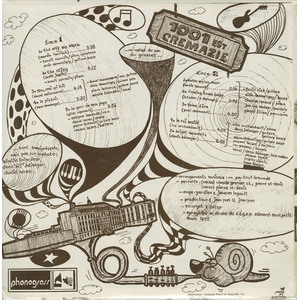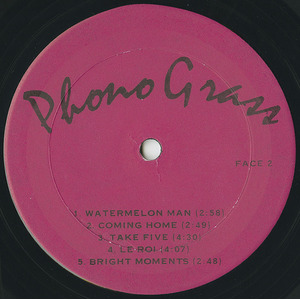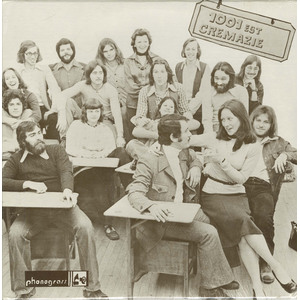Information/Write-up
An inspired product of 1970s Quebec, 1001 est Crémazie captures a remarkable moment of youthful ambition, musical diversity, and cultural vitality in a rapidly changing society.
Recorded in 1975 by the Rocking Grass Band — a lively collective of students and teachers at Montreal’s Collège André-Grasset — the album grew out of the excitement generated by a series of sold-out performances at the school. With support from the institution, and encouragement from socio-cultural animator Jean-Yves Quesnel, the group partnered with colleagues from Cégep Édouard-Montpetit to record the sessions at the college’s modest studio facilities. Pressed privately in a run of just 500 copies, 1001 est Crémazie was initially distributed within a small community of friends, students, and supporters.
Stylistically, the album is a testament to the musical diversity of the era. While often celebrated for its jazz and funk elements — especially on the standout original tracks "Le Roi Muffé" and "Bright Moments" — the album also features interpretations of contemporary and traditional Quebec pieces, such as Gilles Vigneault’s “Les gens de mon pays” and Beau Dommage’s “Le Picbois.” These choices highlight the band's wide-ranging influences and ability to bridge local cultural identity with broader musical trends.
Beyond its musical range, 1001 est Crémazie reflects the spirit of Quebec’s Quiet Revolution — a period of profound educational, social, and cultural transformation. In a newly reimagined Cégep system that promoted creativity and critical thinking, the album embodies the youthful energy, experimentation, and collective spirit that defined a generation.
For many years, 1001 est Crémazie remained an obscure artifact, known mainly to those involved in its creation. That began to shift in the early 2000s, when the track “Bright Moments” was featured on the Canadian Racer compilation (2002), drawing attention from DJs and collectors for its rhythmic conga-and-piano breaks. Drawing from three original copies of the LP, a higher-fidelity composite was produced here to better preserve the album’s original dynamics and warmth. 1001 est Crémazie gained further visibility when it was formally archived at CitizenFreak.com in April 2012.
Recognizing its historical and musical value, Toronto label We Are Busy Bodies spearheaded a full remaster and reissue in 2025 to celebrate the album’s 50th anniversary. Restored by Steve Lewin, remastered by Noah Mintz, and accompanied by new liner notes from Stefane Campbell, the reissue brings this once-forgotten classic to a wider audience for the first time.
Among the participants, pianist Benoît Sarrasin went on to build a successful professional music career, working with major Quebec artists including Marie Denise Pelletier and Diane Tell. For many others, the experience remained a cherished memory — a snapshot of a creative moment when collaboration, enthusiasm, and community spirit gave birth to something lasting.
Today, 1001 est Crémazie is more than a collector’s item; it is a living document of a cultural awakening, a musical bridge between generations, and a powerful reminder of how the spirit of youth can leave an enduring imprint on history.
-Robert Williston
Alain Demontigny: bass guitar, guitar solo
Benoit Sarrazin: piano, xylophone
Pierre Lachance: bass guitar
Mireille Falardeau: vocals
Daniel Maisonneuve: voice, guitar, songwriter
Daniel Neveu: piano
Evelyne Lamonde: voice
Vincent Leclerc: drums
Jean-Luc Nadeau: drums
Farid Risk: guitar
Gérald Filion: percussion
Chantal Renaud: piano
Denis Bélanger: bass guitar, guitar, vocals, songwriter
Luc Archambault: piano, songwriter
Luc Wiseman: bongos
Colette Sigouin: vocals
Jacques Legault: vocals
Louise Demers: vocals
Lucie Nadeau: vocals
Produced by Jean-Yves Quesnel
Ange-gardien (Guardian Angel): Jacques Legault
Escargot: Oscar
Recorded at Studio CÉGEP Édouard-Montpetit, Longueuil, Quebec (March 1975)
1001 est Crémazie: From Phonogramme to Phono Grass
Picture it: 1975, a concert imagined, produced and brought to the stage by a flock of middle-schoolers who wanted to make music to echo the sounds of jazz and rock, generally uninhibited - and deeply anchored in their time.
The “Rocking Grass” show created quite an event, filling the Collège André Grasset auditorium to capacity: “We had to squeeze everyone who didn't have room into the auditorium, into the corridors and right up to the main entrance!” A success as unexpected as it was resounding, under the stunned gaze of several hundred spectators, spellbound by the orchestra.
From the ashes of this first concert, Jean-Yves Quesnel - at the time a socio-cultural animator, then returning to his first love, teaching history - seized the opportunity and surrounded himself with a few natural allies among his colleagues, wanting the orchestra to resonate beyond the stage, by immortalizing it on tape. Fast forward a few weeks and the “Rocking Grass” becomes the “Phono Grass” as they team up with colleagues from Collège Edouard-Monpetit to invest in the college's studios and immortalize the aptly named 1001 est Crémazie.
“We hid a recorder in Benoit Sarrazin's piano (pianist on two tracks on the album) without him even knowing it. We just told him afterwards,” recalls a laughing Quesnel. Mr. Sarrazin, then a college professor, would himself become a professional pianist, eventually completing a doctorate in musicology.
“This record reflects the spirit of an era, the birth of modern Quebec, a renewed vitality,” recalls the producer, ‘the echoes of a Quiet Revolution, which was still rumbling and trying to be heard.’ It was therefore in phase with this pivotal moment in the Quebec ecosystem - which decompartmentalized the school system and gave birth to the Cégeps - that 1001 est Crémazie was born.”
This album is a bit of a mishmash of amateur enthusiasm, of course, but even more so, a cultural and social effervescence that frees itself from standards and leaves room for experimentation and a hitherto unsuspected creative dazzle. This has certainly contributed to the professional development of almost half of the personnel who took part in the recording of the album.
The album includes two original compositions, “Le roi muffé” and the highly acclaimed “Bright moments”, driven by an unusual combination of piano and conga, which found its way onto the Canadian Racer compilation, a jazz reference in the early 2000s. DJs and/or hip-hop aficionados were quick to appropriate and sample the percussive drum and conga solo into the skeletons of a few danceable tracks that set the mood on dance floors.
Now, fifty years and a few upside-down existences later, 1001 est Crémazie, originally printed in a run of 500 copies (now coveted by the most discerning collectors), has been given a facelift to offer itself to the public, much to the delight of the main man involved: “May you get all the pleasure out of this long game that they had recording it!” he says, just before interrupting the conversation to join a dinner party of friends in the company of former colleagues and students. “That's the power of music. Friendships that are nurtured and aged like fine wine!”
Liner Notes: Stefane Campbell
Layout & Restoration: Steve Lewin
Remastered by: Noah Mintz
Special Thanks: Patrick Caron, John Kong, Alain Demontigny, Pierre St-Denis and Jean-Yves Quesnel





No Comments